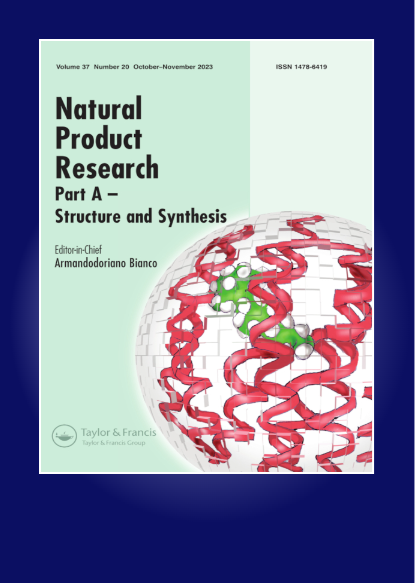Phytochemical profiling, antibacterial and antioxidant potential of different parts of invasive plant Sonchus wightianus DC
IF 1.6
3区 化学
Q3 CHEMISTRY, APPLIED
引用次数: 0
Abstract
The aim of the present investigation was to elucidate the phytochemical characterisation, antimicrobial and antioxidant efficacies of methanol extracts of leaf, stem, and root parts of S. wightianus. The phytochemical characterisation by GC-MS analysis revealed the presence of different phytocompounds such as Lupenone (38.02% in leave extract), Leupeyl acetate (33.43% in root extract), 24- Noursa −3, 12- diene (27.16% stem extract). S. wightianus methanol extracts demonstrate IC50, 8.52 µg/ml, 7.72 µg/ml and 9.08 µg/ml using DPPH, FRAP and MCA scavenging assay, respectively. The antibacterial activity of different methanol extracts was evaluated against four microorganisms with a mean zone diameter of inhibition ranging from 13 to 19 mm. For quantitative phytochemical analysis, the highest Total Phenolic Content (TPC) and Total Flavonol Content (TFC-2) were found for steam methanol extract (321.7 mg GAE/g of dry extract, 162.4 mg QE/g of dry extract respectively).
入侵植物 Sonchus wightianus DC 不同部位的植物化学成分分析、抗菌和抗氧化潜力。
本研究旨在阐明 Wightianus 的叶、茎和根的甲醇提取物的植物化学特征、抗菌和抗氧化功效。通过气相色谱-质谱(GC-MS)分析进行的植物化学特征描述发现了不同的植物化合物,如羽扇豆酮(叶提取物中的含量为 38.02%)、乙酸白皮酯(根提取物中的含量为 33.43%)、24-胭脂红-3,12-二烯(茎提取物中的含量为 27.16%)。在 DPPH、FRAP 和 MCA 清除试验中,S. wightianus 甲醇提取物的 IC50 值分别为 8.52 µg/ml、7.72 µg/ml 和 9.08 µg/ml。评估了不同甲醇提取物对四种微生物的抗菌活性,平均抑制区直径为 13 至 19 毫米。在植物化学定量分析中,发现蒸汽甲醇提取物的总酚含量(TPC)和总黄酮醇含量(TFC-2)最高(分别为 321.7 毫克 GAE/克干提取物和 162.4 毫克 QE/克干提取物)。
本文章由计算机程序翻译,如有差异,请以英文原文为准。
求助全文
约1分钟内获得全文
求助全文
来源期刊

Natural Product Research
化学-医药化学
CiteScore
5.10
自引率
9.10%
发文量
605
审稿时长
2.1 months
期刊介绍:
The aim of Natural Product Research is to publish important contributions in the field of natural product chemistry. The journal covers all aspects of research in the chemistry and biochemistry of naturally occurring compounds.
The communications include coverage of work on natural substances of land and sea and of plants, microbes and animals. Discussions of structure elucidation, synthesis and experimental biosynthesis of natural products as well as developments of methods in these areas are welcomed in the journal. Finally, research papers in fields on the chemistry-biology boundary, eg. fermentation chemistry, plant tissue culture investigations etc., are accepted into the journal.
Natural Product Research issues will be subtitled either ""Part A - Synthesis and Structure"" or ""Part B - Bioactive Natural Products"". for details on this , see the forthcoming articles section.
All manuscript submissions are subject to initial appraisal by the Editor, and, if found suitable for further consideration, to peer review by independent, anonymous expert referees. All peer review is single blind and submission is online via ScholarOne Manuscripts.
 求助内容:
求助内容: 应助结果提醒方式:
应助结果提醒方式:


